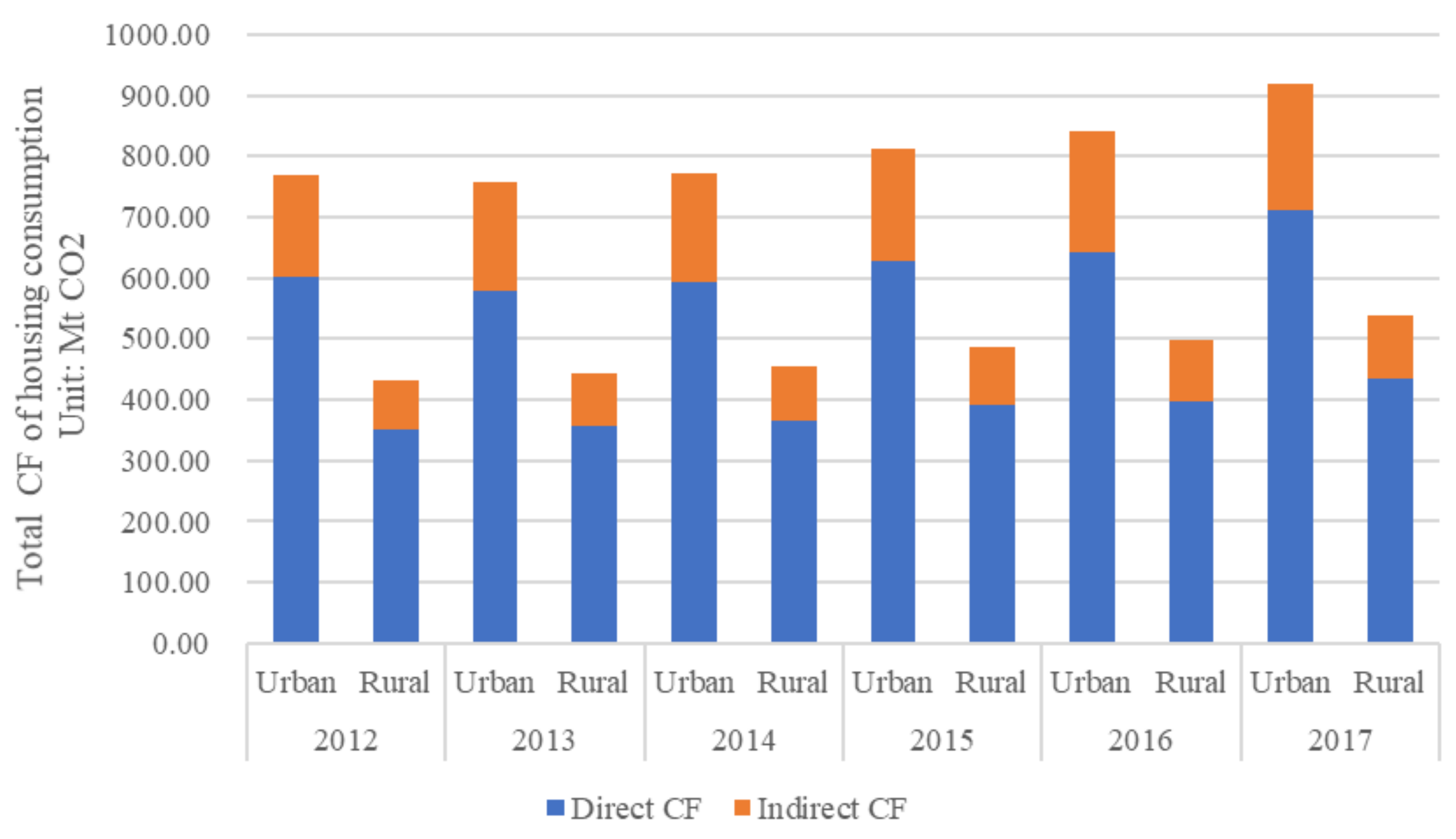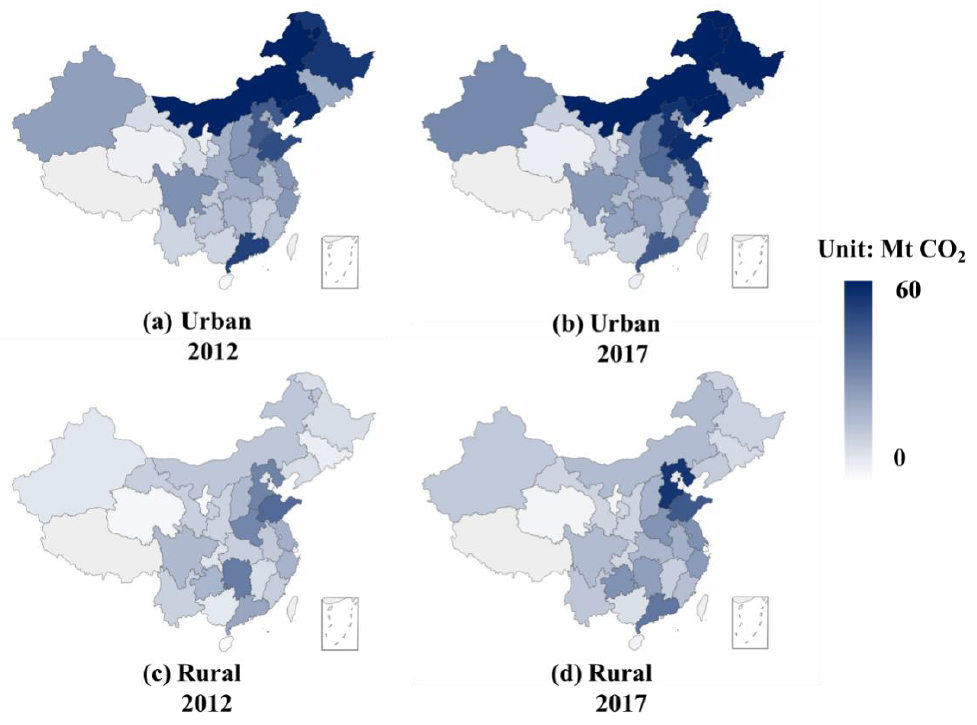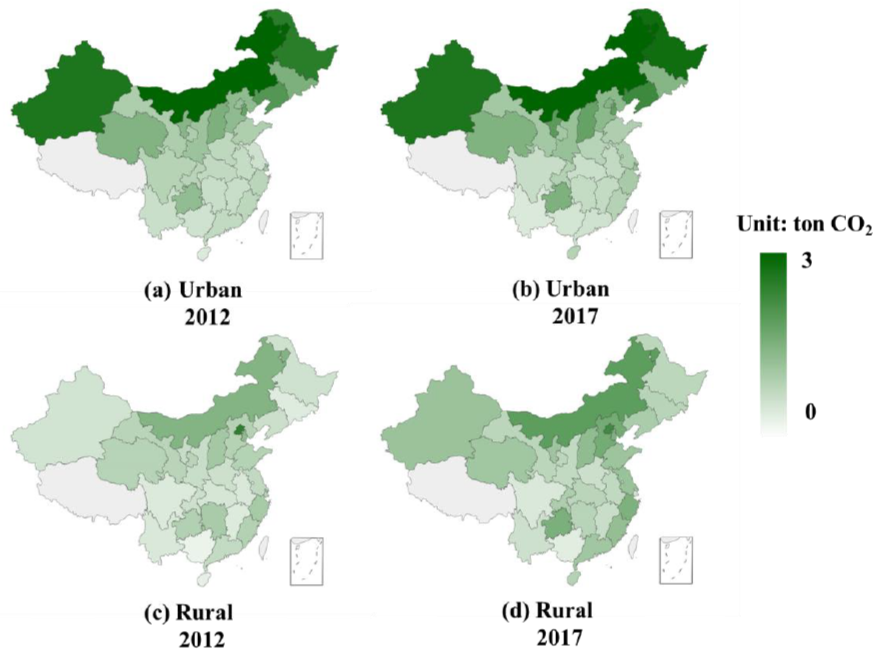Carbon Footprint of Residents’ Housing Consumption and Its Driving Forces in China
Abstract
:1. Introduction
2. Methods and Data
2.1. Accounting Boundary
2.2. Direct CF of Housing Consumption
2.3. Indirect CF of Housing Consumption
2.4. STIRPAT Model
2.5. Data Sources
3. Results
3.1. CF of Housing Consumption at National Level
3.2. Total CFs of Housing Consumption at Provincial Level
3.3. Per Capita CF of Housing Consumption at Provincial Level
3.4. Estimation Results from the STIRPAT Model
4. Policy Implications
4.1. Controlling Population Growth and Promoting Urbanization Benefits
4.2. Encouraging Green Consumption
4.3. Optimizing Energy Structure
4.4. Enhancing Residential Building Energy Management
5. Conclusions
Supplementary Materials
Author Contributions
Funding
Institutional Review Board Statement
Informed Consent Statement
Data Availability Statement
Acknowledgments
Conflicts of Interest
References
- Intergovernmental Panel on Climate Change (IPCC). Global Warming of 1.5 °C.; Intergovernmental Panel on Climate Change (IPCC): Geneva, Switzerland, 2018. [Google Scholar]
- BP Statistical Review of World Energy. 2020. Available online: https://www.bp.com/en/global/corporate/news-and-insights/press-releases/bp-statistical-review-of-world-energy-2020-published.html (accessed on 23 November 2020).
- Xinhua News Agency. President Xi Delivered an Important Speech during the General Debate of the 75th Session of the United Nations General Assembly. Available online: http://www.gov.cn/xinwen/2020-09/22/content_5546168.htm?gov (accessed on 23 November 2020).
- Wiedenhofer, D.; Guan, D.; Liu, Z.; Meng, J.; Zhang, N.; Wei, Y.M. Unequal household carbon footprints in China. Nat. Clim. Chang. 2017, 7, 75–80. [Google Scholar] [CrossRef] [Green Version]
- Cao, Q.; Kang, W.; Xu, S.; Sajid, M.J.; Cao, M. Estimation and decomposition analysis of carbon emissions from the entire production cycle for Chinese household consumption. J. Environ. Manag. 2019, 247, 525–537. [Google Scholar] [CrossRef] [PubMed]
- Hertwich, E.G.; Peters, G.P. Carbon footprint of nations: A global, trade-linked analysis. Environ. Sci. Technol. 2009, 43, 6414–6420. [Google Scholar] [CrossRef] [PubMed] [Green Version]
- Tian, X.; Geng, Y.; Dong, H.; Dong, L.; Fujita, T.; Wang, Y.; Zhao, H.; Wu, R.; Liu, Z.; Sun, L. Regional household carbon footprint in China: A case of Liaoning province. J. Clean. Prod. 2016, 114, 401–411. [Google Scholar] [CrossRef]
- Shi, S.; Yin, J. Global research on carbon footprint: A scientometric review. Environ. Impact Assess. Rev. 2021, 89, 106571. [Google Scholar] [CrossRef]
- Qu, J.; Liu, L.; Zeng, J.; Zhang, Z.; Pei, H.; Dong, L.; Liao, Q. Household CO2 emissions: An assessment based a large sample survey in China. Kexue Tongbao Chin. Sci. Bull. 2018, 63, 547–557. [Google Scholar] [CrossRef]
- Bin, S.; Dowlatabadi, H. Consumer lifestyle approach to US energy use and the related CO2 emissions. Energy Policy 2005, 33, 197–208. [Google Scholar] [CrossRef]
- Jesper, M.; KlausAlsted, P.; Mette, W. Impact of household consumption on CO2 emissions. Energy Econ. 2000, 22, 423–440. [Google Scholar]
- Yang, T.; Liu, W. Inequality of household carbon emissions and its influencing factors: Case study of urban China. Habitat Int. 2017, 70, 61–71. [Google Scholar] [CrossRef]
- Liu, X.; Wang, X.; Song, J.; Duan, H.; Wang, S. Why are the carbon footprints of China’s urban households rising? An input-output analysis and structural decomposition analysis. Sustainability 2019, 11, 7157. [Google Scholar] [CrossRef] [Green Version]
- Ottelin, J.; Heinonen, J.; Nässén, J.; Junnila, S. Household carbon footprint patterns by the degree of urbanisation in Europe. Environ. Res. Lett. 2019, 14, 114016. [Google Scholar] [CrossRef] [Green Version]
- National Bureau of Statistics (NBS). Explanation of Residential Housing Consumption. Available online: http://www.stats.gov.cn/tjsj/zbjs/201912/t20191202_1713055.html (accessed on 2 December 2019).
- Tsinghua University Building Energy Research Centre. China Building Energy Use 2020; China Architecture & Building Press: Beijing, China, 2020. [Google Scholar]
- Zhou, Q.; Zhang, X.; Chen, J.; Zhang, Y. Do double-edged swords cut both ways? Housing inequality and haze pollution in Chinese cities. Sci. Total Environ. 2020, 719, 137404. [Google Scholar] [CrossRef] [PubMed]
- Wang, Q. Study on building energy consumption statistic and calculation in China. Energy Sav. Environ. Prot. 2007, 8, 9–10. (In Chinese) [Google Scholar]
- Huo, T.; Ren, H.; Zhang, X.; Cai, W.; Feng, W.; Zhou, N.; Wang, X. China’s energy consumption in the building sector: A Statistical Yearbook-Energy Balance Sheet based splitting method. J. Clean. Prod. 2018, 185, 665–679. [Google Scholar] [CrossRef]
- Tsinghua University Building Energy Research Centre. China Building Energy Use 2008; China Architecture & Building Press: Beijing, China, 2008. [Google Scholar]
- Zhang, Y.; Yan, D.; Hu, S.; Guo, S. Modelling of energy consumption and carbon emission from the building construction sector in China, a process-based LCA approach. Energy Policy 2019, 134, 110949. [Google Scholar] [CrossRef]
- Wang, Y.; Yang, G.; Dong, Y.; Cheng, Y.; Shang, P. The scale, structure and influencing factors of total carbon emissions from households in 30 provinces of China-based on the extended STIRPAT model. Energies 2018, 11, 1125. [Google Scholar] [CrossRef] [Green Version]
- Ehrlich, P.R.; Holdren, J.P. Impact of population growth. Science 1971, 171, 1212–1217. [Google Scholar] [CrossRef] [PubMed]
- Dietz, T.; Rosa, E.A. Effects of population and affluence on CO2 emissions. Proc. Natl. Acad. Sci. USA 1997, 94, 175–179. [Google Scholar] [CrossRef] [Green Version]
- York, R.; Rosa, E.A.; Dietz, T. STIRPAT, IPAT and ImPACT: Analytic tools for unpacking the driving forces of environmental impacts. Ecol. Econ. 2003, 46, 351–365. [Google Scholar] [CrossRef]
- Dong, F.; Yu, B.; Hua, Y.; Zhang, S.; Wang, Y. A comparative analysis of residential energy consumption in urban and rural China: Determinants and regional disparities. Int. J. Environ. Res. Public Health 2018, 15, 2507. [Google Scholar] [CrossRef] [Green Version]
- Fu, B.; Wu, M.; Che, Y.; Wang, M.; Huang, Y.; Bai, Y. The strategy of a low-carbon economy based on the STIRPAT and SD models. Acta Ecol. Sin. 2015, 35, 76–82. [Google Scholar] [CrossRef]
- Wang, P.; Wu, W.; Zhu, B.; Wei, Y. Examining the impact factors of energy-related CO2 emissions using the STIRPAT model in Guangdong Province, China. Appl. Energy 2013, 106, 65–71. [Google Scholar] [CrossRef]
- Liddle, B.; Lung, S. Age-structure, urbanization, and climate change in developed countries: Revisiting STIRPAT for disaggregated population and consumption-related environmental impacts. Popul. Environ. 2010, 31, 317–343. [Google Scholar] [CrossRef] [Green Version]
- Yang, Y.; Zhao, T.; Wang, Y.; Shi, Z. Research on impacts of population-related factors on carbon emissions in Beijing from 1984 to 2012. Environ. Impact Assess. Rev. 2015, 55, 45–53. [Google Scholar] [CrossRef]
- Yao, J.; Liu, L.; Yuan, Y. Growth of carbon footprint of Chinese household consumption during the recent two decades and its future trends. Acta Sci. Circumstantiae 2017, 37, 2403–2408. [Google Scholar]
- Dong, H.; Geng, Y. Study on Carbon Footprint of the Household Consumption in Beijing Based on Input-Output Analysis. Resour. Sci. 2013, 34, 494–501. (In Chinese) [Google Scholar]
- Wei, Y.M.; Liu, L.C.; Fan, Y.; Wu, G. The impact of lifestyle on energy use and CO2 emission: An empirical analysis of China’s residents. Energy Policy 2007, 35, 247–257. [Google Scholar] [CrossRef]
- Intergovernmental Panel on Climate Change (IPCC). Guidelines for National Greenhouse Gas Inventories; Intergovernmental Panel on Climate Change (IPCC): Geneva, Switzerland, 2006. [Google Scholar]
- National Development and Reform Commission (NDRC). The Average Carbon Dioxide Emission Factor of China’s Regional Power Grid in 2011 and 2012; NDRC: Beijing, China, 2014. Available online: http://www.tanpaifang.com/tanjiliang/2014/0928/38588.html (accessed on 23 November 2020).
- Cohen, C.; Lenzen, M.; Schaeffer, R. Energy requirements of households in Brazil. Energy Policy 2005, 33, 555–562. [Google Scholar] [CrossRef]
- Mi, Z.; Meng, J.; Green, F.; Coffman, D.M.; Guan, D. China’s “exported carbon” peak: Patterns, drivers, and implications. Geophys. Res. Lett. 2018, 45, 4309–4318. [Google Scholar] [CrossRef] [Green Version]
- Shao, S.; Zhang, K.; Dou, J. Effects of economic agglomeration on energy saving and emission reduction: Theory and empirical evidence from China. Manag. World 2019, 35, 36–60+233. [Google Scholar] [CrossRef]
- Zhao, C.; Chen, B.; Hayat, T.; Alsaedi, A.; Ahmad, B. Driving force analysis of water footprint change based on extended STIRPAT model. Ecol. Indic. 2014, 47, 43–49. [Google Scholar] [CrossRef]
- Zhang, S.; Zhao, T. Identifying major influencing factors of CO2 emissions in China: Regional disparities analysis based on STIRPAT model from 1996 to 2015. Atmos. Environ. 2019, 207, 136–147. [Google Scholar] [CrossRef]
- Liu, D.; Bowen, X. Can China achieve its carbon emission peaking? A scenario analysis based on STIRPAT and system dynamics model. Ecol. Indic. 2018, 93, 647–657. [Google Scholar] [CrossRef]
- National Development and Reform Commission (NDRC). The People’s Republic of China National Greenhouse Gas Inventory 2005; China Architecture & Building Press: Beijing, China, 2014.
- National Government Office Administrations. Statistical System of Energy and Resource Consumption of Public Institutions. Available online: http://www.ggj.gov.cn/2017stop/ggjgjn/ggjgjnzwgk/ggjgjntzgg/201207/t20120710_12055.htm (accessed on 23 November 2020).
- Shan, Y.; Guan, D.; Zheng, H.; Ou, J.; Li, Y.; Meng, J.; Mi, Z.; Liu, Z.; Zhang, Q. China CO2 emission accounts 1997-2015. Sci. Data 2018, 5, 170201. [Google Scholar] [CrossRef] [Green Version]
- Shan, Y.; Liu, J.; Liu, Z.; Xu, X.; Shao, S.; Wang, P.; Guan, D. New provincial CO2 emission inventories in China based on apparent energy consumption data and updated emission factors. Appl. Energy 2016, 184, 742–750. [Google Scholar] [CrossRef] [Green Version]
- Shan, Y.; Huang, Q.; Guan, D.; Hubacek, K. China CO2 emission accounts 2016–2017. Sci. Data 2020, 7, 54. [Google Scholar] [CrossRef] [Green Version]
- National Bureau of Statistics (NBS). China Statistical Yearbook, 2013–2018; China Statistics Press: Beijing, China, 2013–2018.
- Liu, J.; Zhao, D.; Liu, S. Research on The Acquisition Method of Actual Building Area Data of Civil Buildings. Build. Sci. 2020, 36, 352–359. (In Chinese) [Google Scholar]
- National Development and Reform Commission (NDRC). Notice on the Implementation of Low-Carbon Community Pilot Work. Available online: http://www.gov.cn/xinwen/2014-03/27/content_2648003.htm (accessed on 21 March 2021).
- Brock, P.M.; Tan, D.K.Y. A second-take on the role of science: The case for applying public administration theory to natural resource management. Sustain. Earth 2020, 3, 1–12. [Google Scholar] [CrossRef] [Green Version]
- Li, L.; Cai, Y.; Liu, L. Research on the Effect of Urbanization on China’s Carbon Emission Efficiency. Sustainability 2020, 12, 163. [Google Scholar] [CrossRef] [Green Version]
- Gilg, A.; Barr, S.; Ford, N. Green consumption or sustainable lifestyles? Identifying the sustainable consumer. Futures 2005, 37, 481–504. [Google Scholar] [CrossRef]
- Chen, H.; Chen, W. Potential impact of shifting coal to gas and electricity for building sectors in 28 major northern cities of China. Appl. Energy 2019, 236, 1049–1061. [Google Scholar] [CrossRef]
- Lin, B.; Wang, Y. Does energy poverty really exist in China? From the perspective of residential electricity consumption. Energy Policy 2020, 143, 111557. [Google Scholar] [CrossRef]
- Ministry of Housing and Urban-Rural. Development of the People’s Republic of China the 13th Five-Year Plan for Building Energy Conservation and Green Building Development. Available online: http://www.mohurd.gov.cn/wjfb/201703/t20170314_230978.html (accessed on 19 June 2021).
- DGRV Energy Cooperatives in Germany: State of the Sector 2020 Report. Available online: https://www.dgrv.de/wp-content/uploads/2020/07/20200708_State-of-the-sector-2020.pdf (accessed on 19 June 2021).
- Geng, Y.; Sarkis, J.; Wang, X.; Zhao, H.; Zhong, Y. Regional application of ground source heat pump in China: A case of Shenyang. Renew. Sustain. Energy Rev. 2013, 18, 95–102. [Google Scholar] [CrossRef]
- Weber, I.; Wolff, A. Energy efficiency retrofits in the residential sector―Analysing tenants’ cost burden in a German field study. Energy Policy 2018, 122, 680–688. [Google Scholar] [CrossRef]
- Barron, M. Going Green in DENVER. J. Hous. Community Dev. 2007, 64, 31–33. [Google Scholar]
- Lv, S.; Wu, Y.; Sun, J. Pattern analysis and suggestion of energy efficiency retrofit for existing residential buildings in China’s northern heating region. Energy Policy 2009, 37, 2102–2105. [Google Scholar] [CrossRef]
- Green Building Council of Australia. Materials Life Cyclxe Impacts. Available online: https://www.gbca.org.au/uploads/78/34894/Materials_Life_Cycle%20Impacts_FINAL_JUNE2014.pdf?_ga=2.241576834.1644031882.1624265622-1696645875.1624162153 (accessed on 21 June 2021).
- Huang, B.; Gao, X.; Xu, X.; Song, J.; Geng, Y.; Sarkis, J.; Fishman, T.; Kua, H.; Nakatani, J. A life cycle thinking framework to mitigate the environmental impact of building materials. One Earth 2020, 3, 564–573. [Google Scholar] [CrossRef]
- Tao, S.; Ru, M.Y.; Du, W.; Zhu, X.; Zhong, Q.R.; Li, B.G.; Shen, G.F.; Pan, X.L.; Meng, W.J.; Chen, Y.L.; et al. Quantifying the rural residential energy transition in China from 1992 to 2012 through a representative national survey. Nat. Energy 2018, 3, 567–573. [Google Scholar] [CrossRef]






| Variables | VIF |
| ln INC | 2.219 |
| ln ES | 1.742 |
| ln ECM2 | 1.507 |
| ln FS | 1.440 |
| ln POP | 1.239 |
| Mean VIF | 1.629 |
| Variables | Variables Explanation | Unit | Data Sources |
|---|---|---|---|
| Population (POP) | Provincial resident population Scale | 104 persons | China Statistical Yearbook |
| Family size (FS) | Population divided by total number of households. | Persons of per household | China Population and Employment Statistics Yearbook |
| Income (INC) | Per capita disposable income | Yuan | China Statistical Yearbook |
| Energy consumption per unit building area (ECM2) 1 | Energy consumption for operation of residential building divided by residential building floor areas | tce/m2 | China Energy Statistical Yearbook, China Rural Statistical Yearbook, China Urban-Rural Construction Statistical Yearbook |
| Energy Structure (ES) | The share of coal in total household energy consumption | % | China Energy Statistical Yearbook |
| Eastern Region | Central Region | Western Region | ||||
|---|---|---|---|---|---|---|
| Urban | Rural | Urban | Rural | Urban | Rural | |
| VARIABLES | ln CF | ln CF | ln CF | ln CF | ln CF | ln CF |
| ln POP | 0.940 *** | 1.065 *** | 0.920 *** | 1.075 *** | 0.832 *** | 0.971 *** |
| (0.043) | (0.030) | (0.064) | (0.068) | (0.082) | (0.031) | |
| ln FS | −1.235 *** | 0.129 | −0.053 | 0.243 | −4.361 *** | −0.298 |
| (0.414) | (0.222) | (0.219) | (0.416) | (0.767) | (0.184) | |
| ln INC | −0.048 | 0.705 *** | −0.061 | 0.160 * | 0.967 | 0.282 *** |
| (0.151) | (0.103) | (0.109) | (0.152) | (0.338) | (0.072) | |
| ln ECM2 | 0.528 *** | 0.654 *** | 0.949 *** | 0.507 *** | 0.377 *** | 0.936 *** |
| (0.079) | (0.099) | (0.048) | (0.089) | (0.120) | (0.055) | |
| ln ES | 0.025 | 0.072 *** | −0.025 | 0.195 ** | 0.088 ** | 0.097 *** |
| (0.020) | (0.025) | (0.027) | (0.079) | (0.040) | (0.018) | |
| Constant | −3.547 * | −13.293 *** | −5.679 *** | −8.126 *** | −9.101 *** | −8.810 *** |
| (1.969) | (1.182) | (1.086) | (1.498) | (2.935) | (0.758) | |
| Observations | 66 | 66 | 48 | 48 | 66 | 66 |
| R-squared | 0.911 | 0.963 | 0.940 | 0.861 | 0.781 | 0.971 |
Publisher’s Note: MDPI stays neutral with regard to jurisdictional claims in published maps and institutional affiliations. |
© 2021 by the authors. Licensee MDPI, Basel, Switzerland. This article is an open access article distributed under the terms and conditions of the Creative Commons Attribution (CC BY) license (https://creativecommons.org/licenses/by/4.0/).
Share and Cite
Xu, L.; Geng, Y.; Wu, D.; Zhang, C.; Xiao, S. Carbon Footprint of Residents’ Housing Consumption and Its Driving Forces in China. Energies 2021, 14, 3890. https://doi.org/10.3390/en14133890
Xu L, Geng Y, Wu D, Zhang C, Xiao S. Carbon Footprint of Residents’ Housing Consumption and Its Driving Forces in China. Energies. 2021; 14(13):3890. https://doi.org/10.3390/en14133890
Chicago/Turabian StyleXu, Liquan, Yong Geng, Dong Wu, Chenyi Zhang, and Shijiang Xiao. 2021. "Carbon Footprint of Residents’ Housing Consumption and Its Driving Forces in China" Energies 14, no. 13: 3890. https://doi.org/10.3390/en14133890






